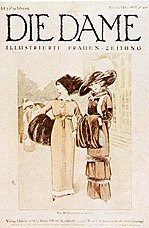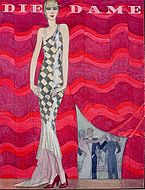81:
218:
reinforcing the "masculinization" of female gender identity, it considered sexual mobility between femininity and masculinity to be the distinguishing feature of women's fashion. In a fashion layout in 1926, the female figures retain feminine styles in their ruffled shirts and ribbon bow ties but appropriate at the same time as excess of masculine styles in their dinner suits and waistcoats which deemphasize the body.
24:
157:
individualization of the modern women, showing geometrical silhouettes arranged in a chorus line. In his works illustrated that women's experience of fashion are completely detached from the understanding of everyday life. They carried the markers of self-centered arrogance that invited many critics of the New Woman to misunderstand the New Woman.
64:(English: Illustrated Women's Newspaper) because the company founder Leopold Ullstein's five sons had already recognized that many women were affluent consumers but that Ullstein had no products specifically for them. The newspaper's content was thrifty advice on fashion and housekeeping. In 1912, the
217:
introduced the spring fashion season with a manipulation of traditional gender roles: sketches of female models in smoking jackets and short masculine haircuts and are accompanied by male models who dress in a similar fashion. Although this representation of the New Woman was frequently condemned for
204:
In World War I, the men had gone to the battlefields and women had to take over the men's jobs. They worked in war factories, hospitals, farms, shops, and single-handedly cared for the children. When the men came back from the war, some of the women resented being pushed back into domestic jobs. By
183:
There is no reliable information about the magazine's readership, but the publisher's concept and price suggest that it circulated among women of the middle and upper-middle classes. A single issue of the journal, which by 1939 had reached a circulation of 32,870, cost 1.50 Reichsmark in the 1920s,
165:
In 1930, Dryden produced a cover design showing an elegant woman clutching a dog and standing in front of a
Bugatti. His cover for November 1928 showing a languid beauty in the middle of a vast circle of sports cars all pointed lustfully towards her, is an image of the Jazz age Woman to match
156:
before being published in book form. By 1927 the photographs of female fashion editors and illustrators disappeared from the pages. Their work was given less and less visible space in the magazine, while Dryden's drawings and essay took over the magazine. His fashion layouts denied the
205:
early 1921, there was a labor shortage and the women were enticed to go back to work. Women's labor and female workers had become widely noticeable since World War I. This caused social disruption and gender recasting. In addition, women were granted the right to vote.
170:
continued to be published under Nazi rule even though their publishing house, Ullstein, was expropriated because it was a Jewish family enterprise. Helen Grund was one of the few fashion journalists of the 1920s whose careers remained.
43:
in
Germany to cater to the interests of modern women. It was also considered the "best journal of its kind in the world market" after the First World War. The lifestyle magazine began in 1911 and ended in 1943.
88:
In the early 1920s, the magazine promoted independent and career driven women. Most of the original fashion layouts and cover pages were created by mostly female designers and artists such as Erica Mohr,
175:
was finally discontinued two years before the end of the war because, as the edition stated, "manpower and material need to be freed up for other purposes in the interests of the war economy."
418:
48:
consisted of essays, illustrations, and photography. The magazine was most active during the shift from the early 1920s, when the magazine celebrated the independent
196:
was publicized by
Ullstein as "the society magazine with an international reputation" and the German luxury magazine with the highest circulation (50,890) in 1929.
98:
106:
94:
114:
102:
90:
423:
113:. The article discussed the phenomenon of fashion within a broader and cultural-historical frame in hopes of enlightening women. In 1923,
356:
398:
393:
408:
388:
413:
403:
283:
251:
339:
366:
310:
8:
186:
362:
335:
328:
306:
279:
247:
141:
300:
273:
241:
140:, which caused a shift from the previous positive tone of modernity. In 1925–26,
136:
In 1925, a
Viennese designer, Ernst Dryden, was named chief artistic director of
52:, to the mid 1920s when women were portrayed as cold and masculine uniformity.
382:
275:
Women in Weimar
Fashion: Discourses and Displays in German Culture, 1918-1933
118:
109:
and costume historian Max von Boehn were granted a large amount of space in
243:
The
Science of Beauty: Culture and Cosmetics in Modern Germany, 1750–1930
149:
358:
Joyless
Streets: Women and Melodramatic Representation in Weimar Germany
80:
40:
128:
s design team which caused the magazine to become more popular.
105:, and Steffie Nathan. Renowned male commentators such as writer
23:
302:
Best-sellers by Design: Vicki Baum and the House of
Ullstein
184:
ten times the cost of a copy of the popular daily newspaper
18:
Defunct illustrated women's magazine in
Germany (1911–1943)
84:
Janina Dłuska, Cover design for Die Dame magazine, 1920s.
60:
In 1912, the Berlin publishing House
Ullstein bought out
117:, the daughter of the well-known modernist architect
327:
380:
330:Nazi Chic?: Fashioning women in the Third Reich
419:Defunct women's magazines published in Germany
39:(English: The Lady) was the first illustrated
208:
166:celebrity, Tamara's iconic self-portrait.
239:
325:
79:
22:
381:
271:
354:
199:
298:
267:
265:
263:
235:
233:
231:
13:
240:Ramsbrock, Annelie (20 May 2015).
14:
435:
424:Defunct women's fashion magazines
399:Defunct German-language magazines
394:1943 disestablishments in Germany
299:King, Lynda J. (1 January 1988).
292:
260:
228:
409:Magazines disestablished in 1943
305:. Wayne State University Press.
389:1911 establishments in Germany
361:. Princeton University Press.
348:
319:
1:
414:Magazines published in Berlin
404:Magazines established in 1911
221:
178:
160:
131:
75:
7:
66:Illustrierte Frauen-Zeitung
62:Illustrierte Frauen-Zeitung
10:
440:
55:
326:Guenther, Irene (2004).
209:Challenging gender roles
355:Petro, Patrice (1989).
150:Rhapsody: A Dream Novel
246:. Palgrave Macmillan.
99:Julie Haase-Werkenthin
85:
31:
272:Ganeva, Mila (2008).
83:
26:
152:) was serialized in
200:Historical context
187:Berliner Tageblatt
86:
32:
142:Arthur Schnitzler
97:, Janina Dłuska,
431:
373:
372:
352:
346:
345:
333:
323:
317:
316:
296:
290:
289:
278:. Camden House.
269:
258:
257:
237:
127:
107:Friedrich Freksa
439:
438:
434:
433:
432:
430:
429:
428:
379:
378:
377:
376:
369:
353:
349:
342:
324:
320:
313:
297:
293:
286:
270:
261:
254:
238:
229:
224:
211:
202:
181:
163:
134:
125:
95:Martha Sparkuhl
78:
58:
19:
12:
11:
5:
437:
427:
426:
421:
416:
411:
406:
401:
396:
391:
375:
374:
367:
347:
340:
318:
311:
291:
284:
259:
252:
226:
225:
223:
220:
210:
207:
201:
198:
180:
177:
162:
159:
133:
130:
77:
74:
57:
54:
17:
9:
6:
4:
3:
2:
436:
425:
422:
420:
417:
415:
412:
410:
407:
405:
402:
400:
397:
395:
392:
390:
387:
386:
384:
370:
364:
360:
359:
351:
343:
337:
332:
331:
322:
314:
308:
304:
303:
295:
287:
285:9781571132055
281:
277:
276:
268:
266:
264:
255:
253:9781137523150
249:
245:
244:
236:
234:
232:
227:
219:
216:
206:
197:
195:
191:
189:
188:
176:
174:
169:
158:
155:
151:
147:
143:
139:
129:
124:
120:
119:Peter Behrens
116:
115:Petra Fiedler
112:
108:
104:
100:
96:
92:
82:
73:
71:
67:
63:
53:
51:
50:The New Woman
47:
42:
38:
37:
29:
25:
21:
16:
357:
350:
329:
321:
301:
294:
274:
242:
214:
212:
203:
193:
192:
185:
182:
172:
167:
164:
153:
146:Traumnovelle
145:
137:
135:
122:
110:
103:Gerda Bunzel
91:Hanna Goerke
87:
69:
65:
61:
59:
49:
45:
35:
34:
33:
27:
20:
15:
341:185973717-X
383:Categories
368:0691008302
312:0814320007
222:References
179:Readership
161:After 1930
148:(English:
213:In 1926,
132:1925-1930
121:, joined
76:1920-1925
334:. Berg.
215:Die Dame
194:Die Dame
173:Die Dame
168:Die Dame
154:Die Dame
138:Die Dame
123:Die Dame
111:Die Dame
70:Die Dame
46:Die Dame
41:magazine
36:Die Dame
28:Die Dame
68:became
56:History
365:
338:
309:
282:
250:
126:'
363:ISBN
336:ISBN
307:ISBN
280:ISBN
248:ISBN
30:1912
144:'s
385::
262:^
230:^
190:.
101:,
93:,
72:.
371:.
344:.
315:.
288:.
256:.
Text is available under the Creative Commons Attribution-ShareAlike License. Additional terms may apply.

